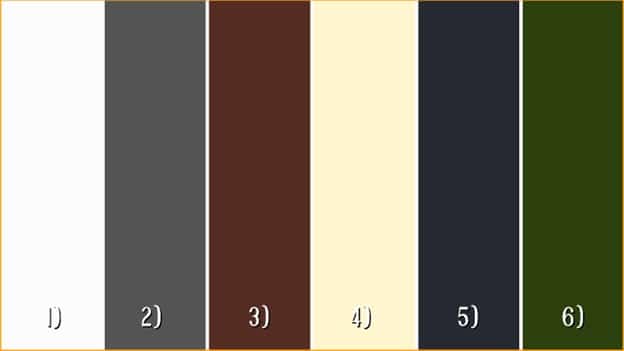The garage door is often ignored during exterior design updates, even though it can occupy a significant portion of the home’s facade. In light of this, selecting a color for the garage door that complements the home can have a major effect on the overall appearance and curb appeal of the house. This is not something that a lot of people put thought into, but it is an easy way to enhance the home’s look and change its character.
Choosing a garage door color isn’t just about personal preference; it should complement your home’s design, architecture, and exterior. The right color creates harmony, enhances curb appeal, and reflects your style and your home’s character, whether you choose bold, neutral, or vibrant shades. In Houston, Texas, where temperatures soar and humidity levels remain high, color selection becomes even more critical for both aesthetic appeal and practical performance.
Choosing the right garage door color involves considering how the shade works with your home’s architectural style. Avoid common mistakes, as the garage door is a key feature that impacts curb appeal and overall visual balance.
Garage Door Color Impact
The color of your garage door has a major effect on your home’s appearance, your property value, and even your energy efficiency and maintenance needs. Considering that garage doors can constitute up to 40% of a home’s front facade, choosing a color (or colors) for your garage door that works with your house design and the kinds of practical and financial issues we list above becomes a pretty important decision.
- Curb Appeal Impact – Garage doors occupy up to 40% of the front facade, making color crucial for home appearance
- Property Value – Homes with coordinated garage door colors sell 7% faster than those with mismatched doors
- Energy Efficiency – Dark colors increase garage temperatures by 10-15°F in summer, affecting energy costs and stored items
- Maintenance Considerations – Light colors (white, gray) show dirt but hide fading better than bold colors
- Color Longevity – Bold colors (red, blue) fade within 5-7 years, while neutral tones last longer
- Temperature Control – Light colors reflect sunlight and maintain cooler interiors, beneficial for attached garages

Top 6 Garage Door Colors for a Red Brick House
Choosing the perfect garage door color for a red brick home takes a lot of thought and care; you have to consider how different colors will work with the warm tones of the brick. The appearance of the hue can change dramatically depending on the sunlight or shadow cast on the door. A color that looks good in direct sunlight might not look so great in shadow or could even give an unexpected visual effect.
1. Classic White
A white garage door creates a striking contrast against the rich tones of a red-brick home. When selecting a color, consider opting for cream or ivory instead of pure white. These softer shades tend to harmonize more effectively with the warm hues of red brick, offering a balanced and appealing aesthetic.
Advantages:
- Creates crisp contrast that brightens the facade
- Complements traditional and colonial brick homes
- Matches easily with white trim and window frames
Considerations:
- Shows dirt and scuffs within 3-6 months
- Requires cleaning 2-3 times annually
2. Deep Gray
Contemporary sophistication is achieved with charcoal and slate gray garage doors on red brick houses. The neutral qualities of gray create a seamless connection between the warm tones of brick and the sleek elements of modern architectural design.
Benefits:
- Provides subtle contrast without overwhelming brick
- Works with cool-toned roofing materials
- Conceals minor scratches and dust
Drawbacks:
- Dark shades increase garage temperature by 10-15°F
- Lighter grays may wash out against certain brick tones
3. Rich Brown
Brown garage doors complement the natural warmth of red brick, offering a unified and cohesive appearance for your home’s exterior. Shades like walnut or chestnut, with subtle red undertones, are ideal choices to enhance and harmonize with the brick’s tones.
Strengths:
- Enhances brick’s natural warmth
- Creates unified appearance with wood accents
- Available in wood-grain textures for added depth
Limitations:
- Dark browns absorb significant heat in southern climates
- Requires precise shade matching to avoid color conflicts
4. Soft Beige or Tan
Beige and tan garage doors provide a subtle, sophisticated appeal, allowing red brick exteriors to take center stage. Sandstone and almond tones are especially well-suited for homes with diverse brick hues.
Advantages:
- Blends seamlessly with mortar lines
- Reflects heat better than dark colors
- Coordinates with limestone or stucco accents
Challenges:
- Shows tire marks and road grime
- May appear bland without architectural details
5. Bold Black
Black garage doors create a striking contrast when paired with red brick exteriors. This bold choice adds a unique and modern touch to your home’s facade, drawing attention and enhancing curb appeal. The combination of black and red brick delivers a visually appealing and sophisticated look that stands out effortlessly.
Positives:
- Delivers maximum visual impact
- Masks dirt and minor imperfections
- Enhances modern and transitional designs
Negatives:
- Increases surface temperature by 20-30°F
- Requires balance through coordinating trim colors
6. Forest Green
Forest green garage doors pair well with red brick due to their complementary relationship on the color wheel. Opt for deep, muted green shades reminiscent of natural foliage instead of brighter emerald tones for a more cohesive and understated look.
Benefits:
- Creates distinctive curb appeal
- Harmonizes with landscaping elements
- Suits Tudor and cottage-style brick homes
- Limits future color scheme changes
- Requires confidence in color selection

Tips for Choosing the Perfect Garage Door Color
Choosing the perfect garage door color involves evaluating several key factors that impact the overall aesthetic of your home. Achieving the best outcome requires balancing practical functionality with thoughtful design principles to enhance curb appeal and align with your unique preferences.
Consider the Overall Color Scheme
Your home’s current color palette serves as the foundation for selecting the ideal garage door color. Factors such as the roof, siding, trim, shutters, and front door should be considered to identify the dominant and accent colors in place. A well-chosen garage door color enhances visual harmony by complementing existing elements rather than creating competition.
For a cohesive design approach, it is important to apply the 60-30-10 rule: 60% for the dominant color, typically the siding; 30% for the secondary color, such as trim and accents; and 10% for the accent color, often the front door. Garage doors generally align with the 30% category, complementing the dominant color while enhancing the overall aesthetic of the design.
Think About the Style of Your Home
Architectural style plays a pivotal role in determining suitable garage door color choices that complement and maintain your home’s overall character. Selecting colors that align with key architectural features ensures a cohesive and harmonious appearance.
- Colonial homes: White, cream, or soft gray doors maintain traditional elegance
- Craftsman style: Earth tones like brown, green, or natural wood stains enhance authentic appeal
- Mediterranean homes: Warm terracotta, deep brown, or rich wood tones complement stucco exteriors
- Modern architecture: Black, charcoal, or metallic finishes emphasize clean lines
- Ranch style: Neutral tones matching the siding create horizontal emphasis
- Victorian homes: Multiple color options work, including bold jewel tones for authentic character
Think About Long-lasting Trends
We emphasize the importance of selecting timeless garage door colors that remain stylish over the years. Shades such as white, gray, black, and brown offer enduring appeal and versatility, effortlessly complementing evolving design trends when paired with updated hardware and accessories.
Current enduring trends include:
- Two-tone combinations: Matching garage door frames to trim while using a contrasting panel color
- Natural wood finishes: Faux wood or stained options that add warmth without extensive maintenance
- Monochromatic schemes: Various shades of the same color family for sophisticated depth
- Black accents: Black hardware and window frames paired with lighter door colors for contemporary contrast
Test Samples
We recommend obtaining physical samples of garage door colors rather than relying solely on digital images. Paint chips or material samples provide an accurate representation of the true color when viewed under the unique lighting and surroundings of your home. Apply these samples directly to the garage door to evaluate how they appear in your specific environment.
- Morning light: Shows cooler tones and true color saturation
- Midday sun: Reveals how colors handle intense light and potential fading
- Evening light: Displays warmer undertones and shadow effects
- Cloudy days: Demonstrates color appearance in diffused light
Consider Maintenance
Different garage door colors require varying levels of maintenance, which can influence long-term satisfaction. Maintenance needs are assessed based on:
Light colors (white, beige, light gray):
- Show dirt, pollen, and stains within 3-6 months
- Requires cleaning 3-4 times annually
- Hide minor scratches and dings effectively
- Reflect heat, reducing garage temperatures by 10-15°F
Dark colors (black, dark brown, navy):
- Conceal dirt but show dust and water spots
- Need cleaning 2-3 times yearly
- Reveal scratches and imperfections more readily
- Absorb heat, increasing garage temperatures by 15-20°F
Medium tones (gray, tan, muted colors):
- Balance dirt visibility and heat absorption
- Requires cleaning 2-3 times annually
- Provide optimal scratch resistance
- Maintain moderate temperature control
Consult a Professional
Seeking professional consultation is advisable when addressing intricate color choices or distinctive architectural considerations.
- Color analysis: Evaluation of undertones and how colors interact with existing elements
- Material expertise: Knowledge of how different door materials accept and maintain color
- Trend awareness: Understanding of neighborhood standards and market preferences
- Technical guidance: Advice on specialty finishes, custom colors, and application methods
Sum Up
Selecting the perfect garage door color transforms your home’s entire appearance and can significantly boost its market value. Remember that your garage door represents a substantial investment that you’ll live with for years. Whether you’re drawn to timeless neutrals or bold statement colors, we encourage you to test samples thoroughly before committing. The right choice enhances your home’s character while potentially reducing energy costs and maintenance headaches.
At Easy Garage Door Repair, our experienced technicians combine design knowledge with practical experience, helping you select colors that not only look stunning but also perform well in your specific climate and conditions. Our consultation service ensures your garage door color choice adds value and appeal to your home for years to come. Call us at 832-570-3845.








